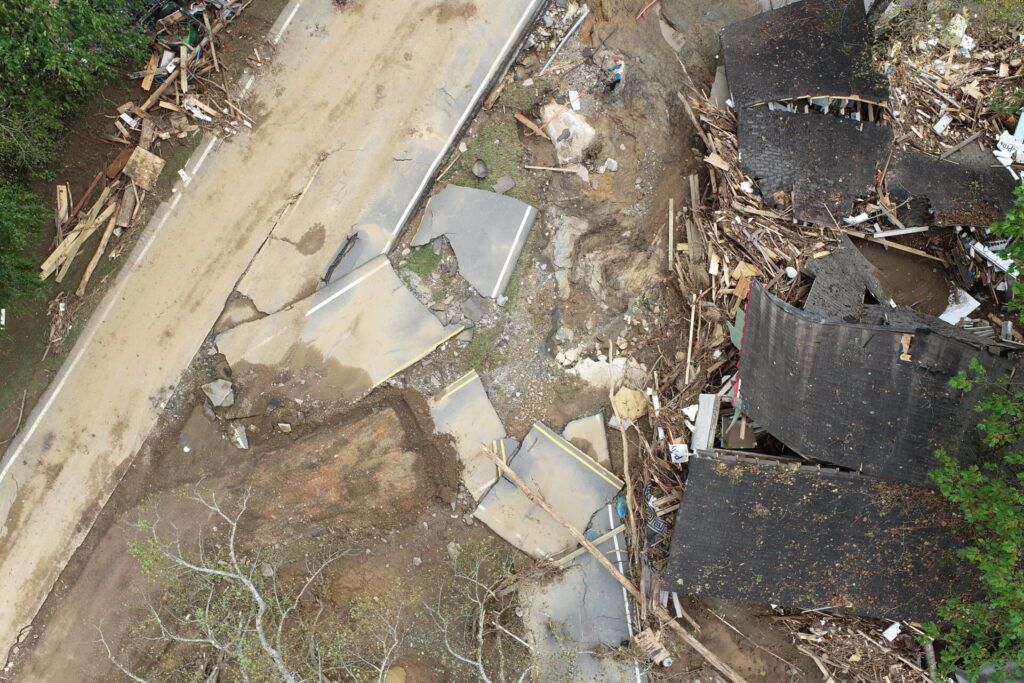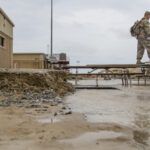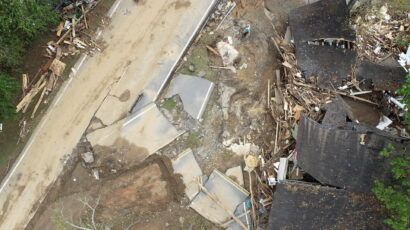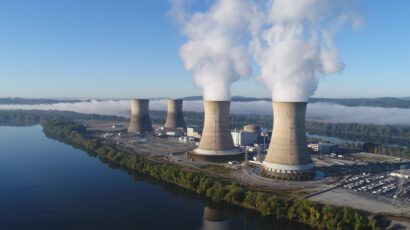How philanthropy could help offset Trump cuts to disaster prevention and recovery
By Taylor Dimsdale | June 6, 2025
 Road damage in Yancey County, North Carolina, from Hurricane Helene. Despite facing an estimated $60 billion in damages, some towns have yet to receive federal funds to repair roads and public buildings. (Photo: North Carolina Department of Transportation/Flickr)
Road damage in Yancey County, North Carolina, from Hurricane Helene. Despite facing an estimated $60 billion in damages, some towns have yet to receive federal funds to repair roads and public buildings. (Photo: North Carolina Department of Transportation/Flickr)
Eight months after Hurricane Helene tore through the Southeastern United States, many communities in North Carolina have yet to fully recover. Despite facing an estimated $60 billion in damages, some towns have yet to receive federal funds to repair roads and public buildings. Meanwhile, federal grants to avoid or minimize future catastrophes have been canceled nationwide. In March, President Donald Trump issued an executive order that aims to shift the burden of disaster preparedness onto state governments, which will need to build up the necessary resources and expertise. With the federal government stepping back, there is a need for other types of organizations to step in and fill in the gaps.
Philanthropic organizations aren’t in the business of taking the easy road. They exist to tackle some of society’s most pernicious and complex challenges, from fighting preventable diseases to improving education to reducing poverty. A common thread across many foundation missions is the goal of advancing positive outcomes in the most vulnerable and chronically under-resourced communities.
Despite dramatically rising costs, US foundations have historically underfunded a key challenge: helping communities build resilience to disasters like floods, hurricanes, and wildfires.
Increasingly, staying on the sidelines seems untenable. Decades of underinvestment in disaster resilience is already biting hard. Over the past decade, more than 6,000 lives have been lost in the United States in disasters that have caused $1.4 trillion in damage. Insurance is becoming unaffordable in high-risk areas, with premiums in the riskiest zip codes 80 percent higher than those in the safest. Rating agencies are warning of credit downgrades for state and local insurers due to failure to address disaster risk.
Meanwhile, data from the research and strategy firm Fors Marsh and the George Mason University Center for Climate Change Communication’s Community Resilience Insights and Survey Project show that the public values the protection provided by disaster resilience. Three-quarters of Americans support their state or local government working to improve public systems such as electrical grids, water supply, and roads to better withstand extreme events. Studies show that adaptation and resilience have a healthy return on investment.
Some foundations have been active in this area for years, and others are stepping up. The Center for Disaster Philanthropy has been working to mobilize philanthropy on this issue for over a decade. The Adaptation and Resilience Collaborative for Funders was formed in 2023 and has been joined by over 60 philanthropies from five continents. So far, they have pledged $50 million for adaptation and resilience projects. Far more is needed. About $600 million in philanthropic money was spent on resilience and adaptation globally in 2023, a pittance compared to a 5-year annual average disaster cost of $149 billion in the United States alone.
Two obvious needs are better local risk assessments and more resilient infrastructure. But private foundations and public charities will never have the scale of resources needed to build massive amounts of disaster-proof buildings or to help each of the thousands of communities across the country develop vulnerability assessments and resilience plans.
Resilience isn’t just about stronger infrastructure, however. It’s also about social networks and human behavior. Different individuals and communities perceive disaster risk differently, which means they prepare for and respond to disasters differently. Whether people invest in mitigation measures can drastically change the severity of an event. A resilience strategy that doesn’t account for people and culture is doomed to fail. This is a gap that philanthropy can help fill.
If they are going to make the best use of limited resources, foundations should align around a strategic and targeted approach that maximizes their leverage. We know a lot about resilient engineering. We know less about how people think, feel, and act in the context of disaster risk or about the effectiveness of programs and policies. Foundations could have an immediate impact in two areas.
The first would be support for rigorous evaluations of existing resilience projects and programs to identify what works and how it can be replicated in different contexts. There’s no time to reinvent the wheel in every location, and most communities don’t have the resources to start from scratch with each disaster anyway. What specific governance reforms are needed to improve disaster resilience coordination across different sectors like water, infrastructure, and healthcare? What nature-based solutions to heat risk are most effective in urban environments? These kinds of assessments could also shed light on which populations benefit most and ensure that resilience efforts don’t reinforce existing disparities.
The second area where philanthropy could make a difference involves efforts to improve the behavioral science related to disasters. We need to know what motivates people to take actions like elevating their homes ahead of a flood or buying wildfire insurance. This could include survey research to measure the gap between physical disaster risk and risk perception or testing the effectiveness of preparedness message frames or risk communications in different regions and with different demographic groups.
Some will argue that more money for resilience will come at the expense of other worthy social causes. The opposite is true. Disasters undermine progress on virtually all social challenges. Low-income neighborhoods are often hit hardest. Disasters can drive up home prices leading to gentrification. They also cause school closures, loss of instructional time, and lower test scores, especially for minorities. Homelessness among students can skyrocket. More people fall below the poverty line. Disasters can have multiple consequences for public health, resulting in a combination of increased demand for services and closure of facilities, followed by a long-term increase in various health issues.
At-risk communities face a future of increasingly severe disasters, less federal support, and the looming threat of credit downgrades that would further reduce already stretched local budgets. With a targeted, strategic approach that draws on their strengths, philanthropic foundations can substantially reduce America’s disaster tax bill while boosting their wider social impact in the process.
Together, we make the world safer.
The Bulletin elevates expert voices above the noise. But as an independent nonprofit organization, our operations depend on the support of readers like you. Help us continue to deliver quality journalism that holds leaders accountable. Your support of our work at any level is important. In return, we promise our coverage will be understandable, influential, vigilant, solution-oriented, and fair-minded. Together we can make a difference.















